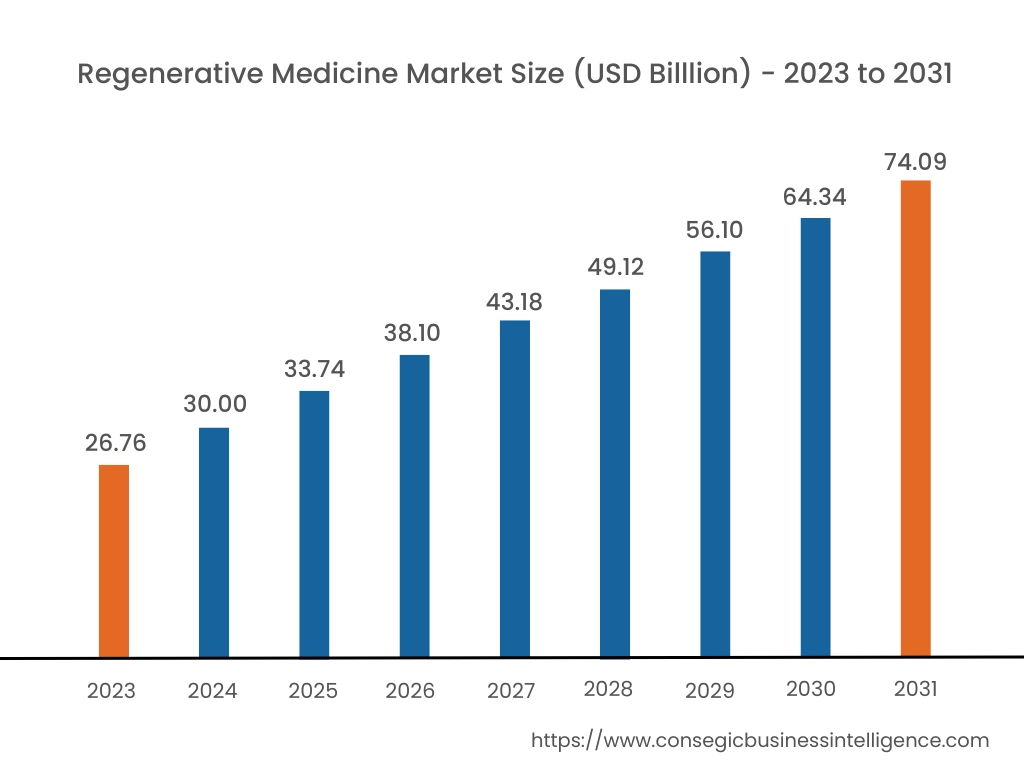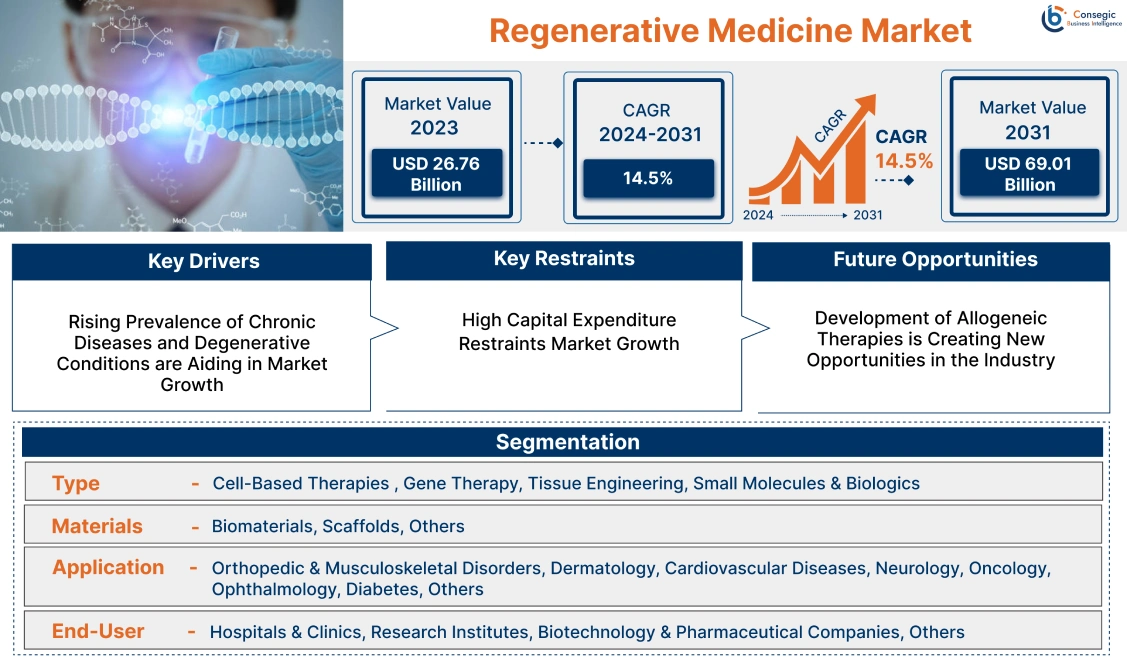- Summary
- Table Of Content
- Methodology
Regenerative Medicine Market Size and Growth 2023 to 2031:
Regenerative Medicine Market size is estimated to reach over USD 74.09 Billion by 2031 from a value of USD 26.76 Billion in 2023, growing at a CAGR of 13.8% from 2024 to 2031. The North American region is valued at 10.64 Billion in 2023.
Regenerative Medicine Market Scope & Overview:
Regenerative medicine is a field of medical science focused on repairing or replacing damaged or diseased cells, tissues, and organs through innovative therapies. It involves the use of stem cells to regenerate or repair damaged tissues and organs. It includes therapies that involve the use of cells to treat diseases, such as autologous or allogeneic cell therapies, where cells are derived from the patient or a donor, respectively. The increasing prevalence of chronic diseases and conditions such as cardiovascular diseases, diabetes, and neurodegenerative disorders increases the demand for regenerative therapies. In the market, hospitals and clinics, biotech and pharmaceutical companies, and research and academic institutions play a crucial role in its adoption, application, and commercialization.
North America Regenerative Medicine Market Size and Growth 2023 to 2031:
In 2023, North America is expected to reach USD 28.50 Billion in 2031. In North America, the U.S. accounted for the highest market share of 66.85% during the base year of 2023.
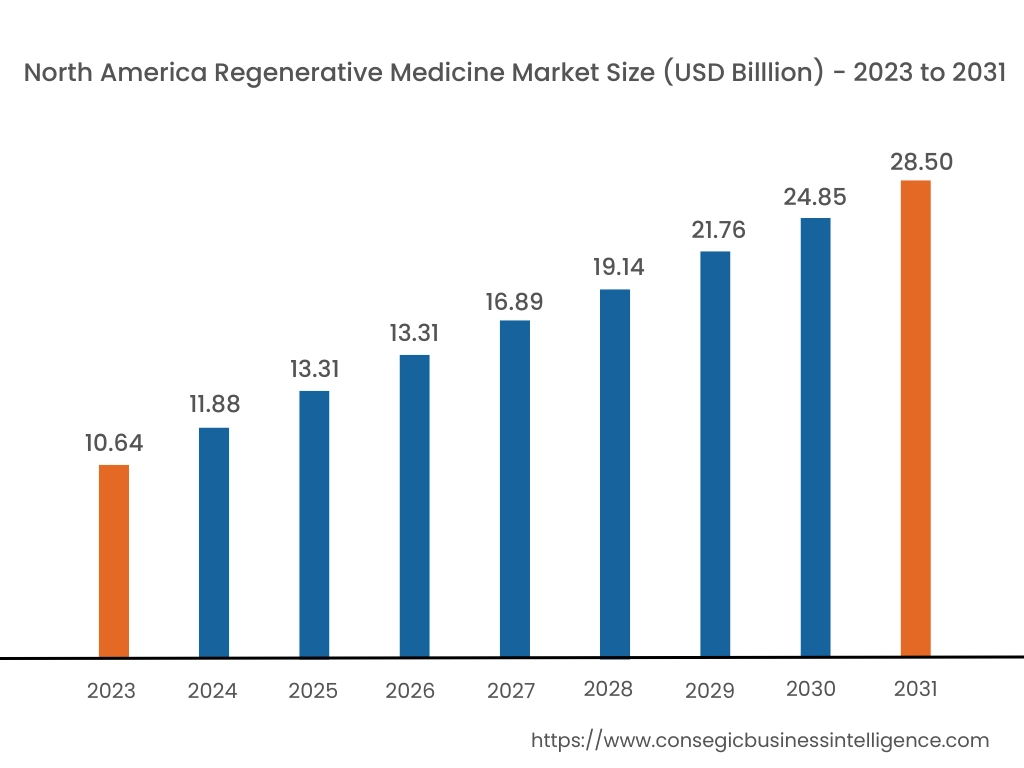
North America's leading position in gene therapies and advanced therapeutic medicinal products reflects its commitment to cutting-edge treatments. They have pioneering research and academic prowess at institutions such as Harvard and MIT, driving advancements in stem cell therapies and tissue engineering. This, in turn, drives the regenerative medicine market expansion in the region.
- In 2024, Mayo Clinic is focusing on a newly redesigned regenerative medicine strategy that will emphasize better biomanufacturing capabilities, with technology platforms supporting the creation of new treatments known as biologics.
Asia plays a pivotal role in stem cell research, contributing significantly to the exploration of embryonic stem cells, induced pluripotent stem cells, and adult stem cells. Countries like Japan and South Korea, actively support regenerative medicine through strategic initiatives and funding.
- In January 2024, EPS Corporation was designated as one of the top ten firms in the Asia-Pacific area as a pioneer in offering regenerative medicine solutions and influencing the market in regenerative medicine solutions providers.
Europe is driven by strong R&D investments and favorable regulatory frameworks, such as the EMA's Advanced Therapy Medicinal Products Regulation. The UK, Germany, and France are leading markets due to their robust healthcare systems and support for innovative therapies. The region has seen significant advancements in stem cell research and tissue engineering, particularly for orthopedic and cardiovascular applications. Germany's focus on biopharmaceutical research and the UK's growing cell and gene therapy sector are notable contributors to market expansion. However, strict regulations and lengthy approval processes can hinder market growth.
The Middle East and Africa region is experiencing steady growth in regenerative medicine, particularly in countries like the UAE and South Africa. The focus is on developing advanced therapies to address the increasing burden of chronic and degenerative diseases. The UAE is investing in stem cell research and setting up specialized healthcare facilities for regenerative treatments. South Africa is emerging as a hub for clinical research in cell-based therapies, supported by government initiatives. Limited healthcare infrastructure and high costs of advanced therapies pose significant challenges for market growth in this region.
Latin America is an emerging market, with Brazil and Mexico leading in regenerative medicine advancements. The region's growth is driven by rising healthcare expenditures, increasing awareness of regenerative therapies, and government support for clinical research. Brazil is focusing on developing stem cell-based treatments for neurological and cardiovascular disorders, while Mexico is expanding its regenerative medicine capabilities in orthopedics and wound care. However, economic instability and limited regulatory frameworks in certain countries pose challenges for market adoption.
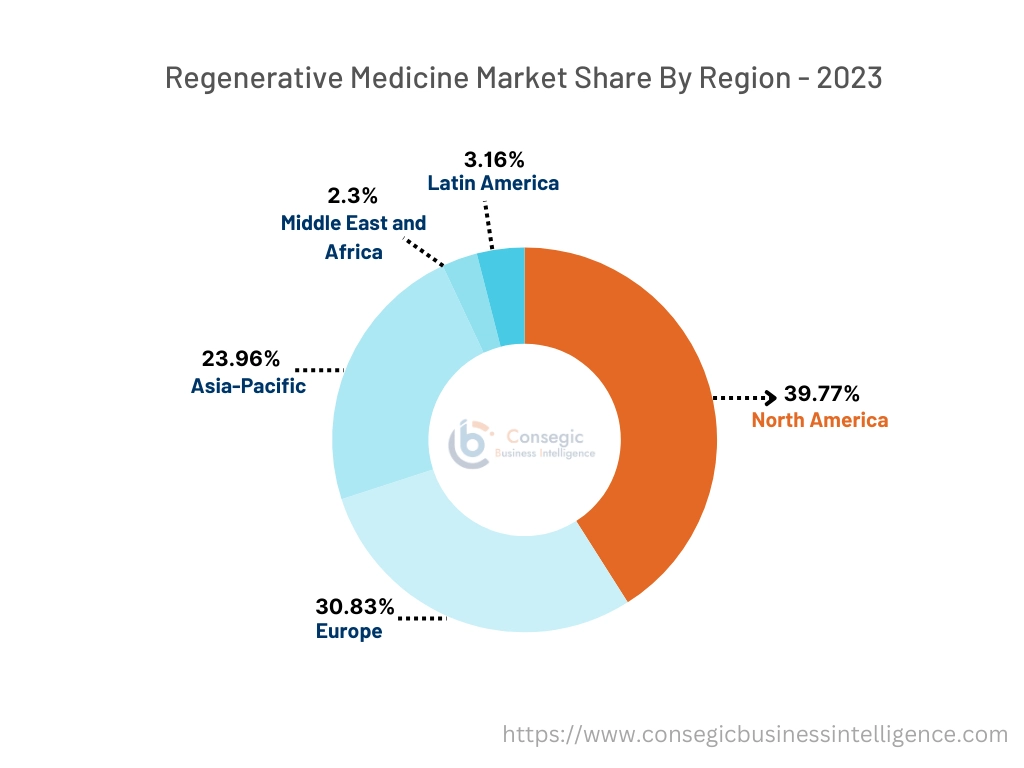
Regenerative Medicine Market Key Players:
The regenerative medicine market is highly competitive with major players providing products and services to the national and international markets. Key players are adopting several strategies in research and development (R&D), product innovation, and end-user launches to hold a strong position in the global regenerative medicine market. Key players in the regenerative medicine industry include –
- Acelity Inc. (USA)
- Medtronic (Ireland)
- MiMedx Group (USA)
- Stryker Corporation (USA)
- Novartis AG (Switzerland)
- Organogenesis Inc. (USA)
- Integra LifeSciences Corporation (USA)
- Vericel Corporation (USA)
- Smith & Nephew (UK)
- Cook Biotech Inc. (USA)
Regenerative Medicine Market Trends:
The regenerative medicine market is experiencing robust growth driven by advancements in stem cell therapies and gene editing technologies. The increasing focus on personalized medicine has led to the development of patient-specific treatments using stem cells to repair or replace damaged tissues. These therapies are gaining traction in treating chronic and degenerative conditions such as osteoarthritis, cardiovascular diseases, and neurodegenerative disorders. As research progresses and clinical trials demonstrate positive outcomes, the adoption of regenerative therapies is expanding rapidly, positioning the market for significant growth.
Another key trend is the growing application of 3D bioprinting in regenerative medicine. 3D bioprinting technologies are being utilized to create complex tissue structures, such as skin grafts and vascular networks, offering new possibilities in tissue engineering and organ regeneration. The ability to produce functional tissue scaffolds is enhancing the effectiveness of regenerative treatments, especially in wound healing and organ transplantation. This technological advancement is not only improving patient outcomes but also addressing the shortage of donor organs.
Moreover, the market is witnessing increased investment and collaborations between biopharmaceutical companies and research institutions. These partnerships are accelerating the commercialization of regenerative therapies and fostering innovations in cell and gene therapy techniques. Strategic alliances are also enabling access to advanced technologies and expertise, further propelling the market's expansion.
However, the high cost of regenerative therapies remains a significant challenge. The complexity of developing and manufacturing these therapies leads to substantial expenses, limiting their accessibility, especially in developing regions. Additionally, regulatory hurdles related to the approval and standardization of new therapies continue to pose obstacles. Overcoming these challenges is essential for making regenerative medicine more accessible and achieving sustainable market growth.
Regenerative Medicine Market Dynamics - (DRO) :
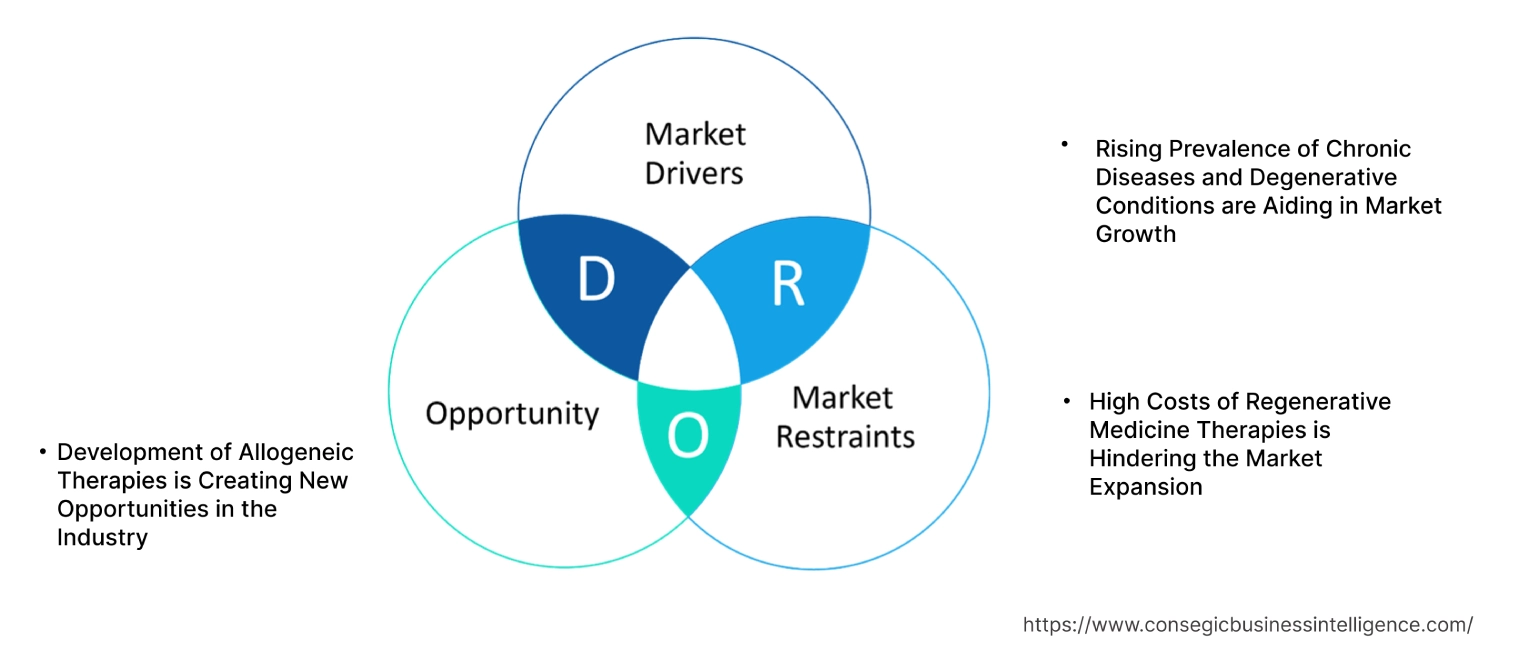
Key Drivers:
Rising Prevalence of Chronic Diseases and Degenerative Conditions are Aiding in Market Growth
Chronic diseases such as diabetes, cardiovascular diseases, and neurodegenerative disorders are becoming more common globally. This growing patient population increases the demand for effective and innovative treatments, boosting the regenerative medicine market growth. Such conditions often require long-term management and treatment. These medicines offer potential solutions for restoring function and improving quality of life. Research is being done on stem cell therapies and tissue engineering to treat conditions such as spinal cord injury, heart disease, and Parkinson's disease.
- For instance, according to OrthoMiami, tissue engineering is an important part of regenerative medicine that is revolutionizing the treatment of chronic diseases. It entails developing artificial tissues and organs in a laboratory for transplantation or healing of damaged tissues in the body.
Therefore, as per the market trends analysis, the demand for innovative and effective treatments is accelerating the development and commercialization of regenerative therapies.
Key Restraints :
High Costs of Regenerative Medicine Therapies is Hindering the Market Expansion
The high costs of regenerative medicine therapies limit access for patients, particularly those without adequate insurance coverage or those in lower-income regions. Inconsistent reimbursement policies and high costs deter patients from pursuing these treatments. The cost of developing and producing these therapies is often high due to complex manufacturing processes, extensive research, and stringent regulatory requirements. High costs slow down the adoption of new therapies, as healthcare providers and patients may be hesitant to invest in expensive treatments without clear evidence of long-term benefits and cost-effectiveness.
- In February 2024, DVCSTEM stated that even with the significant increase in demand for stem cell treatments still, they are exceedingly costly to pursue. Advanced treatments almost cost $100000 and minor joint injections range from $5000.
Therefore, as per the regenerative medicine market analysis, the high costs of these therapies pose a significant restraint on market expansion and patient access.
Future Opportunities :
Development of Allogeneic Therapies is Creating New Opportunities in the Industry
The development of allogeneic therapies presents a significant opportunity for growth and innovation within the market. Allogeneic therapies, which involve the use of cells or tissues from a donor rather than the patient's cells, offer several potential benefits and open up new avenues for advancing regenerative medicine. The development of ‘off-the-shelf' allogeneic products enables faster and more convenient access to treatments, reducing waiting times for patients and potentially lowering costs. Innovations in genetic engineering and immunoediting techniques aim to reduce the risk of immune rejection of allogeneic therapies.
- In 2024, according to the examples of allogenic cell therapies mesenchymal stem cells (MSCs) have immunomodulatory capabilities that treat autoimmune illnesses , tissue damage, and inflammatory disorders. MSCs can treat several patients using a single donor.
Therefore, the growth and impact of allogeneic therapies will shape the future of the regenerative medicine market opportunities.
Regenerative Medicine Market Segmentation Review:
Type Analysis:
Based on type the market is segmented into Cell-Based Therapies (Stem Cell Therapy, Somatic Cell Therapy, and Gene-Modified Cells), Gene Therapy, Tissue Engineering, and Small Molecules & Biologics.
Trends in the Type:
- Recent technological advancements in cell processing, expansion, and manipulation have improved the efficacy and safety of cell-based therapies.
- The development of next-generation gene editing technologies, such as base editing and epigenome editing, holds promise for further enhancing the precision and applicability of gene therapies.
The cell-based therapies segment accounted for the largest revenue share of 31.35% in the year 2023.
- Cell-based therapies are used to treat a broad spectrum of conditions, including cancer, cardiovascular diseases, neurological disorders, autoimmune diseases, and orthopedic injuries.
- Advances in cell-based therapies, such as stem cell treatments, immunotherapies, and regenerative cell therapies, are driving significant interest and investment.
- Biotech companies, pharmaceutical firms, and research institutions are investing in developing and commercializing these therapies.
- Thus, the dominance of cell-based therapies in the market underscores their critical role and potential in transforming patient care across a range of medical conditions. This, in turn, drives the regenerative medicine market demand.
The gene therapy segment is anticipated to register the fastest CAGR during the forecast period.
- Gene editing technologies, such as CRISPR/Cas9, and other genomic editing tools are significantly enhancing the precision and effectiveness of gene therapies.
- Gene therapy has the potential to address a wide range of medical conditions, including genetic disorders, cancers, infectious diseases, and autoimmune diseases.
- Advances in delivery mechanisms, such as viral vectors, nanoparticles, and electroporation, are improving the efficiency and safety of gene transfer into target cells.
- For instance, US FDA has approved only two commercially available gene therapy products Novartis' Zolgensma and Spark Therapeutics' Luxturna.
- Thus, technological advancements, successful clinical outcomes, and increasing demand for treatments are likely to drive regenerative medicine market trends.
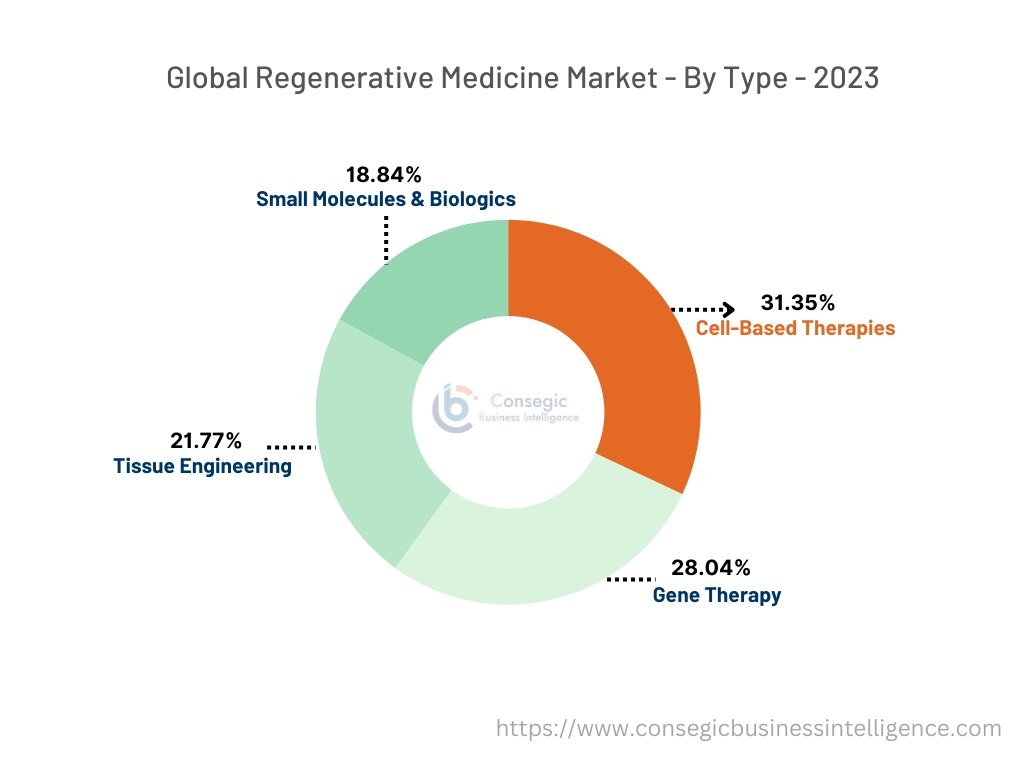
Material Analysis:
Based on material the market is segmented into Biomaterials (Natural Biomaterials and Synthetic Biomaterials), Scaffolds, and others.
Trends in the Material:
- The development of responsive and adaptive biomaterials, such as those that release drugs in response to environmental stimuli, offers new prospects for therapeutic applications.
- Bioprinting and nanotechnology are projected to fuel further developments in scaffold fabrication.
The biomaterials segment accounted for the largest revenue of the total regenerative medicine market share in 2023.
- Biomaterials are used in various applications, including tissue engineering, regenerative medicine, orthopedics, wound healing, and drug delivery systems.
- The increasing prevalence of chronic diseases, such as cardiovascular diseases, diabetes, and orthopedic conditions, drives the usage of biomaterials used in implants, prosthetics, and tissue engineering.
- Innovations such as biodegradable polymers and advanced hydrogels are driving growth.
- For instance, metallic biomaterials are used in clinical settings on a large scale because of their exceptional endurance and mechanical qualities. It has strong corrosion resistance and mechanical durability which supports orthopedic implants.
- Thus, as per the segmental trends analysis, the versatility and proven efficacy of biomaterials in various medical contexts contribute to the regenerative medicine market demand.
The scaffolds segment is anticipated to register the fastest CAGR during the forecast period.
- Advances in scaffold materials, including biodegradable polymers, hydrogels, and bioactive materials, are enhancing the functionality and effectiveness of scaffolds.
- The use of 3D printing and additive manufacturing techniques is revolutionizing scaffold fabrication.
- Scaffolds play a crucial role in supporting the regeneration of tissues and organs, such as skin, bone, cartilage, and vascular tissues.
- Scaffolds are being explored for new applications beyond traditional tissue engineering, such as in the development of organ-on-a-chip models, personalized medicine, and drug testing platforms.
- For instance, the number of technologies capable of processing biomaterials for scaffold production, such as electrospinning and 3D printing, has increased, leading to the creation of innovative techniques that are used in tissue engineering and regenerative medicine research.
- Thus, innovations in scaffold materials and fabrication technologies, coupled with the expansion into new applications and personalized solutions, are driving the regenerative medicine market trends.
Application Analysis:
Based on application the market is segmented into Orthopedic & Musculoskeletal Disorders, Dermatology, Cardiovascular Diseases, Neurology, Oncology, Ophthalmology, Diabetes, and others.
- Integration with digital health technologies, such as wearable sensors and smart implants, will enhance the monitoring and management of orthopedic conditions, driving further growth in the market.
- Continued advancements in regenerative medicine technologies, such as advanced biomaterials and neuro-engineering, are expected to drive the neurology segment.
The orthopedic & musculoskeletal disorders application accounted for the largest revenue of the total regenerative medicine market share in the year 2023.
- Orthopedic and musculoskeletal disorders, such as osteoarthritis, rheumatoid arthritis, spinal injuries, and fractures, are highly prevalent worldwide.
- Recent advancements in regenerative medicine, including stem cell therapies, tissue engineering, and advanced biomaterials, are significantly improving treatment outcomes for orthopedic and musculoskeletal disorders.
- The scope of regenerative therapies in orthopedics is expanding to include new indications, such as complex bone fractures, cartilage regeneration, and spinal cord injuries.
- Thus, the orthopedic and musculoskeletal disorders segment due to the high prevalence of orthopedic conditions, advancements in regenerative therapies, and successful clinical outcomes drive the regenerative medicine market growth.
The neurology segment is anticipated to register the fastest CAGR during the forecast period.
- Neurological disorders such as Parkinson's disease, Alzheimer's disease, multiple sclerosis, and spinal cord injuries are prevalent and increasing globally.
- Research is expanding into new areas within neurology, including treatments for chronic pain, epilepsy, and neurodevelopmental disorders. This broadens the scope of regenerative medicine applications.
- The use of stem cells for neurodegenerative disease treatment and neural tissue repair presents significant opportunities.
- For instance, practices in neuro regenerative emphasize the expeditious development of independence in doing daily activities as they aid in the improvement of motor functions in patients having neurological impairments.
- Thus, the neurology segment is anticipated to register the fastest due to the rising incidence of neurological disorders, advancements in regenerative medicine, and successful clinical trials.
End User Analysis:
Based on end-user the market is segmented into Hospitals & Clinics, Research Institutes, Biotechnology & Pharmaceutical Companies, and others.
Trends in the End User:
- Rising healthcare expenditure and investment in medical facilities support the growing hospitals and clinics segment.
- The introduction of new regenerative therapies and products will enhance the market presence of these companies and contribute to their growth.
The hospitals & clinic applications accounted for the largest revenue share in the year 2023.
- Hospitals and clinics serve as the primary settings for the administration of regenerative medicine therapies, including stem cell treatments, gene therapies, and advanced surgical procedures.
- Many hospitals and clinics have specialized departments or centers dedicated to regenerative medicine, which enhances their capability to deliver advanced therapies and attract a higher volume of patients.
- For instance, PHI's first collaboration with University College London setting to investigate clinical applications of the HoloMonitor M4FL system which will be used in an ongoing research project at UCL. It also enables PHI to investigate the clinical applications of the company's QPI technology and how it can make advanced regenerative treatments more accessible and cost-effective.
- Thus, as per the market trends analysis, the integration of new technologies, increased healthcare expenditure, and the rising prevalence of chronic diseases drive the regenerative medicine market opportunities.
The biotechnology & pharmaceutical companies segment is anticipated to register the fastest CAGR during the forecast period.
- Biotechnology and pharmaceutical companies are instrumental in developing new drugs and biologics that leverage regenerative medicine principles, leading to significant breakthroughs and expanding treatment options.
- They are increasingly integrating digital health technologies, such as wearable sensors and AI-driven diagnostics, into their products, enhancing the effectiveness and reach of regenerative treatments.
- Thus, continued innovation, strategic investments, and expansion into new markets will be essential for biotechnology and pharmaceutical companies to lead the market.
Recent Industry Developments :
Product launches:
- In July 2024, Bioserve India launched its advanced stem cell products in India which aims to develop regenerative medicine and expand its distribution of stem cell therapy products in the Indian Market. It is also going to provide antibodies, proteins, and genomic analysis kits for studying cellular mechanisms.
Clinical Trials and Research:
- In October 2023, Editas Medicine received FDA Regenerative Medicine Advanced Therapy (RMAT) designation for EDIT-301 for the treatment of severe sickle cell disease.
Partnerships and Collaborations:
- In June 2024, The Alliance for Regenerative Medicine and the Council for Advanced Regenerative Medicine formed a strategic partnership to advance regulatory harmonization of cell and gene therapies in the United States and Korea. This alliance marks a new age of innovation and progress in advanced regenerative medicine.
Regenerative Medicine Market Report Insights :
| Report Attributes | Report Details |
| Study Timeline | 2018-2031 |
| Market Size in 2031 | USD 74.09 Billion |
| CAGR (2024-2031) | 13.8% |
| By Type |
|
| By Materials |
|
| By Application |
|
| By End User |
|
| By Region |
|
| Key Players |
|
| North America | U.S. Canada Mexico |
| Europe | U.K. Germany France Spain Italy Russia Benelux Rest of Europe |
| APAC | China South Korea Japan India Australia ASEAN Rest of Asia-Pacific |
| Middle East and Africa | GCC Turkey South Africa Rest of MEA |
| LATAM | Brazil Argentina Chile Rest of LATAM |
| Report Coverage |
|
Key Questions Answered in the Report
How big is the regenerative medicine Market? +
Regenerative Medicine Market size is estimated to reach over USD 74.09 Billion by 2031 from a value of USD 26.76 Billion in 2023, growing at a CAGR of 13.8% from 2024 to 2031.
Which is the fastest-growing region in the regenerative medicine market? +
The fastest-growing region in the regenerative medicine market is Asia-Pacific.
What specific segmentation details are covered in the regenerative medicine market report? +
The specific segments that are covered in the regenerative medicine market are type, materials, application, and end-user.
Who are the major players in the regenerative medicine market? +
The major players in the regenerative medicine market are Acelity Inc. (USA), Medtronic (Ireland), Organogenesis Inc. (USA), Integra LifeSciences Corporation (USA), MiMedx Group (USA), Stryker Corporation (USA), Novartis AG (Switzerland), Vericel Corporation (USA), Smith & Nephew (UK), and Cook Biotech Inc. (USA)
